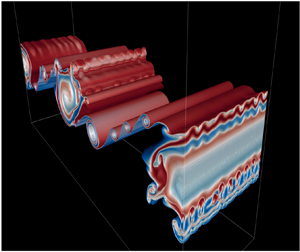No CrossRef data available.
Article contents
Turbulence and mixing from neighbouring stratified shear layers
Published online by Cambridge University Press: 13 May 2024
Abstract

Studies of Kelvin–Helmholtz (KH) instability have typically modelled the initial mean flow as an isolated stratified shear layer. However, geophysical flows frequently exhibit multiple layers. As a step towards understanding these flows, we examine the case of two adjacent stratified shear layers using both linear stability analysis and direct numerical simulations. With sufficiently large layer separation, the characteristics of instability and mixing converge towards the familiar KH turbulence, and similarly when the separation is near zero and the layers add to make a single layer, albeit with a reduced Richardson number. Here, our focus is on intermediate separations, which produce new and complex phenomena. As the separation distance  $D$ increases from zero to a critical value
$D$ increases from zero to a critical value  $D_c$, approximately half the thickness of the shear layer, the growth rate and wavenumber both decrease monotonically. The minimum Richardson number is relatively low, potentially inducing pairing, and shear-aligned convective instability (SCI) is the primary mechanism for transition. Consequently, mixing is relatively strong and efficient. When
$D_c$, approximately half the thickness of the shear layer, the growth rate and wavenumber both decrease monotonically. The minimum Richardson number is relatively low, potentially inducing pairing, and shear-aligned convective instability (SCI) is the primary mechanism for transition. Consequently, mixing is relatively strong and efficient. When  $D\sim D_c$, billow length is increased but growth is slowed. Despite the modest growth rate, mixing is strong and efficient, engendered primarily by secondary shear instability manifested on the braids, and by SCI occurring on the eyelids. Shear-aligned vortices are driven in part by buoyancy production; however, shear production and vortex stretching are equally important mechanisms. When
$D\sim D_c$, billow length is increased but growth is slowed. Despite the modest growth rate, mixing is strong and efficient, engendered primarily by secondary shear instability manifested on the braids, and by SCI occurring on the eyelids. Shear-aligned vortices are driven in part by buoyancy production; however, shear production and vortex stretching are equally important mechanisms. When  $D>D_c$, neighbouring billow interactions suppress the growth of both KH instability and SCI. Strength and efficiency of mixing decrease abruptly as
$D>D_c$, neighbouring billow interactions suppress the growth of both KH instability and SCI. Strength and efficiency of mixing decrease abruptly as  $D_c$ is exceeded. As turbulence decays, layers of marginal instability may arise.
$D_c$ is exceeded. As turbulence decays, layers of marginal instability may arise.
- Type
- JFM Papers
- Information
- Copyright
- © The Author(s), 2024. Published by Cambridge University Press





